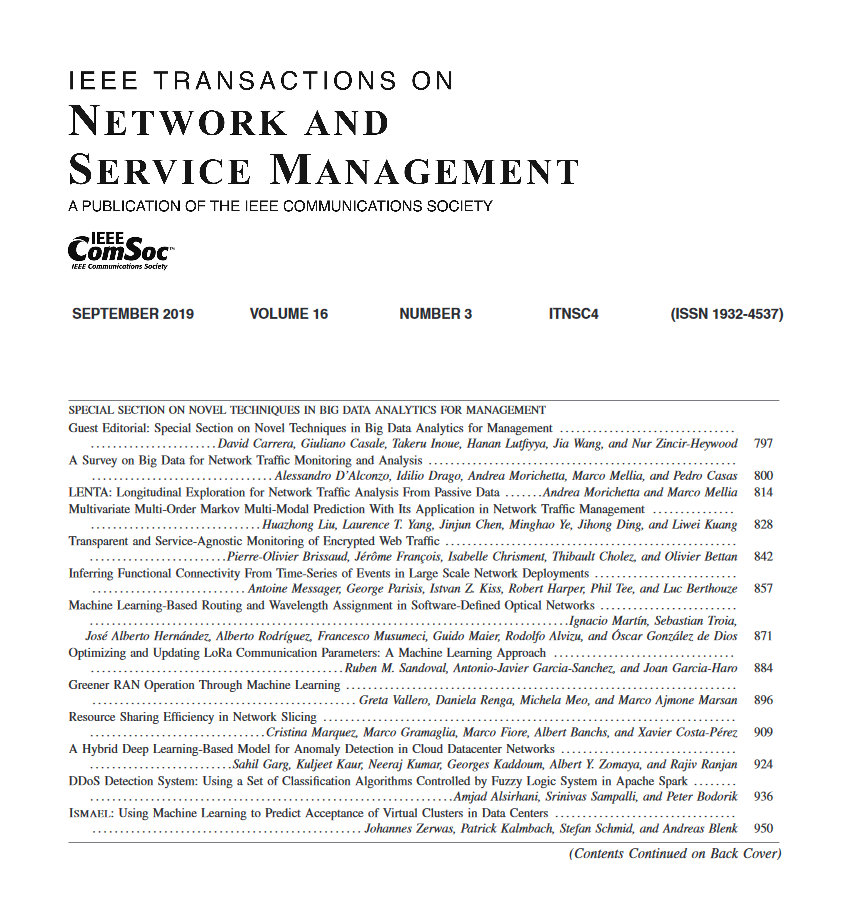Joint Controller Placement and TDMA Scheduling in Software Defined Wireless Multihop Networks
IF 5.4
2区 计算机科学
Q1 COMPUTER SCIENCE, INFORMATION SYSTEMS
IEEE Transactions on Network and Service Management
Pub Date : 2025-04-09
DOI:10.1109/TNSM.2025.3559104
引用次数: 0
Abstract
We study TDMA-scheduled Software Defined Wireless Multihop Networks (SDWMNs), whereby the data traffic and SDN control messages share the same network links and TDMA resources. Since the topology of WMNs dynamically changes, maintaining a responsive SDN plane is essential for meeting data traffic rate requirements. Placing more SDN controllers reduces communication delays at the SDN layer and increases its responsiveness. However, it demands more TDMA resources and reduces the available ones for data traffic. We analyze this trade-off between data traffic performance and SDN layer responsiveness by delving into two distinct resource allocation mechanisms in the WMN, the SDN controller placement and TDMA scheduling. We capture their interaction into an optimization problem formulation, which aims at maximizing the SDN-responsiveness subject to data traffic rate requirements, topology conditions, and the available TDMA resources. We propose a novel heuristic for the hard-to-solve problem that leverages the network state information gathered at the SDN layer. We find that our heuristic can increase the SDN-responsiveness by 44% when varying the rate reserved for rate-elastic data traffic within 40% of what is nominally requested. The heuristic is modular in accommodating different controller placement algorithms and robust to different alternative for the SDN software implementation.软件定义无线多跳网络中的联合控制器布置与TDMA调度
我们研究了TDMA调度的软件定义无线多跳网络(SDWMNs),其中数据流量和SDN控制消息共享相同的网络链路和TDMA资源。由于wmn的拓扑结构是动态变化的,因此维护响应式SDN平面对于满足数据流量速率要求至关重要。放置更多的SDN控制器可以减少SDN层的通信延迟,并提高其响应能力。然而,它需要更多的TDMA资源,并减少了可用的数据流量。我们通过深入研究WMN中的两种不同的资源分配机制,即SDN控制器放置和TDMA调度,来分析数据流量性能和SDN层响应性之间的权衡。我们将它们的相互作用捕获到一个优化问题公式中,该公式旨在根据数据流量速率要求、拓扑条件和可用的TDMA资源最大化sdn响应性。我们提出了一种新的启发式方法,利用在SDN层收集的网络状态信息来解决这个难以解决的问题。我们发现,当在名义请求的40%以内改变为速率弹性数据流量保留的速率时,我们的启发式方法可以将sdn响应性提高44%。启发式是模块化的,可以适应不同的控制器放置算法,并且对SDN软件实现的不同替代方案具有鲁棒性。
本文章由计算机程序翻译,如有差异,请以英文原文为准。
求助全文
约1分钟内获得全文
求助全文
来源期刊

IEEE Transactions on Network and Service Management
Computer Science-Computer Networks and Communications
CiteScore
9.30
自引率
15.10%
发文量
325
期刊介绍:
IEEE Transactions on Network and Service Management will publish (online only) peerreviewed archival quality papers that advance the state-of-the-art and practical applications of network and service management. Theoretical research contributions (presenting new concepts and techniques) and applied contributions (reporting on experiences and experiments with actual systems) will be encouraged. These transactions will focus on the key technical issues related to: Management Models, Architectures and Frameworks; Service Provisioning, Reliability and Quality Assurance; Management Functions; Enabling Technologies; Information and Communication Models; Policies; Applications and Case Studies; Emerging Technologies and Standards.
 求助内容:
求助内容: 应助结果提醒方式:
应助结果提醒方式:


